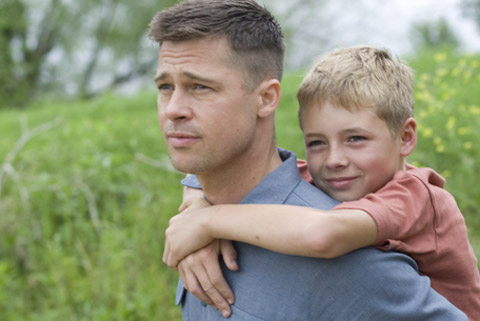
GENIUS OR FOLLY? The banal profundities of Terrence Malick’s fifth feature film (with Brad Pitt and Laramie Eppler) are hard to ignore, but so is the breathtaking beauty. |
Since his debut film, Badlands (1973), one of the best movies in one of greatest decades in American cinema, Terrence Malick has made only four other features, each secreted with oyster-like, Kubrickian meticulousness. In each new opus his knack for ravishing images and montages has grown — as has his weakness for sophomoric ideas that, in print, would not be out of place in the New-Age section of a Barnes and Noble, next to Deepak Chopra. It makes for an unlikely mix of the exquisitely sophisticated and the baldly ingenuous. Yet disparate though these extremes are, they combine to make The Tree of Life Malick's best work since his first film.
True, the banal profundities are hard to ignore. Muttered throughout in voiceovers, they consist of the questions that really bother a guy, like, "Where are you, God? . . . What do we mean to You? . . . Why did that boy die?" and pat consolations like "Unless you love, your life will flash by."
But these adolescent musings are the low-hanging fruit on The Tree. They are the white noise of consciousness, the unending human prayer, unanswered by God and Malick both, and here focused in the microcosmic points of view of the O'Brien family in Waco, Texas, in the 1950s. The mother (Jessica Chastain) looks like a Pre-Raphaelite angel, and she is likewise angelic in her nurturing of her three boys. The troubled, anal-retentive father (Brad Pitt) is full of bitterness and guilt, which he takes out at times on his sons. Two of the brothers, Jack (Hunter McCracken) and R.L. (Laramie Eppler) — beset by the domestic tension, torn between the disparate natures of their parents, and stricken by their growing awareness of wickedness and mortality — form a wordless bond.
The story is primal, but the details are elusive. Much of it is seen in flashbacks from the adult Jack (Sean Penn), an architect lost in the steel and glass of skyscrapers, and these fragments are as oblique and elliptical as the philosophizing is overt. In one scene the children are shunted into the house by the mother, but briefly glimpsed in the background is the father standing over someone who's thrashing on the lawn. Who is it? What's going on? After two viewings, I still don't know.
On the other hand, these childhood memories seem at times less Proustian reveries than the best home movie ever made, or a trailer for a Nicholas Ray family melodrama that never was. I confess I found the plight of the frightened, wide-eyed Parasaurolophus cowering beneath Cretaceous-era trees almost as affecting as the O'Brien's dreary unhappiness.
Which brings us to the dinosaurs, and the film's recap of the 15-billion-year history of the cosmos, from Big Bang through the first emergence of life from the sea with a protracted stopover in '50s Waco and on to the end of time. That's putting things in perspective, all right. Jaw-dropping folly or breath-taking genius?